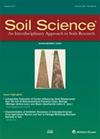Effects of environmental factors on the influence of tillage conversion on saturated soil hydraulic conductivity obtained with different methodologies: a global meta-analysis
4区 农林科学
Q2 Agricultural and Biological Sciences
引用次数: 2
Abstract
Abstract. The saturated hydraulic conductivity (Ksat) is a key soil hydraulic property governing agricultural production. However, the influence of the conversion from the conventional tillage (CT) to conservation tillage (CS; including no tillage, NT, and reduced tillage, RT) on the Ksat of soils is not well understood and still debated. In this study, we applied a global meta-analysis method to synthesize 227 paired observations for soil Ksat from 69 published studies and investigated factors influencing the effects of conversion to CS on Ksat. Results showed that soil layer, conservation tillage type, soil texture type, and cropping system management did not have significant effects on the influence of conversion to CS on Ksat. When the Ksat was measured by the rainfall simulator, the conversion to CS significantly (p<0.05) increased the surface and subsurface soil Ksat by 41.7 % and 36.9 %, respectively. In addition, the subsurface Ksat also tended to increase under CS practices when the Ksat was measured by a tension disc infiltrometer. However, when the Ksat was measured by a hood infiltrometer, ring infiltrometer, constant/falling head, and Guelph permeameter, the conversion to CS had no significant effects on the Ksat. It is observed that, when the conversion period was less than 15 years, the Ksat under CS showed a greater increase for a longer conversion period. Climatic and topographic factors, including the mean annual temperature (MAT) and the mean annual precipitation (MAP), were statistically related to the responses of Ksat to tillage conversion at the global scale. Quadratic polynomials can describe the relationships between them. These findings suggested that quantifying the effects of tillage conversion on soil Ksat needed to consider experimental conditions, especially the measurement technique and conversion period.环境因素对不同耕作方式对饱和土壤导电性影响的影响:一项全球荟萃分析
摘要饱和导电性(Ksat)是影响农业生产的关键土壤水力特性。然而,从传统耕作(CT)向保护性耕作(CS)转变的影响;包括免耕(NT)和减耕(RT)对土壤Ksat的影响还没有得到很好的理解,并且仍在争论中。在本研究中,我们采用全球荟萃分析方法,综合了69篇已发表的研究中227对土壤Ksat的观测结果,并研究了转化为CS对Ksat的影响因素。结果表明:土层、保护性耕作类型、土壤质地类型和耕作制度管理对退耕还林对Ksat的影响不显著;当降雨模拟器测量Ksat时,转化为CS显著(p<0.05)提高了地表和地下土壤Ksat,分别提高了41.7%和36.9%。此外,当使用张力盘式渗透计测量Ksat时,在CS做法下,地下Ksat也有增加的趋势。然而,当使用罩式渗透计、环形渗透计、恒定/下降水头和圭尔夫渗透计测量Ksat时,转换为CS对Ksat没有显著影响。可以看出,当转换期小于15年时,CS下的Ksat随着转换期的延长而增加。气候和地形因子,包括年平均温度(MAT)和年平均降水(MAP),在全球尺度上与Ksat对耕作转化的响应有统计学关系。二次多项式可以描述它们之间的关系。这些结果表明,量化耕作转制对土壤Ksat的影响需要考虑试验条件,特别是测量技术和转制周期。
本文章由计算机程序翻译,如有差异,请以英文原文为准。
求助全文
约1分钟内获得全文
求助全文
来源期刊

Soil Science
农林科学-土壤科学
CiteScore
2.70
自引率
0.00%
发文量
0
审稿时长
4.4 months
期刊介绍:
Cessation.Soil Science satisfies the professional needs of all scientists and laboratory personnel involved in soil and plant research by publishing primary research reports and critical reviews of basic and applied soil science, especially as it relates to soil and plant studies and general environmental soil science.
Each month, Soil Science presents authoritative research articles from an impressive array of discipline: soil chemistry and biochemistry, physics, fertility and nutrition, soil genesis and morphology, soil microbiology and mineralogy. Of immediate relevance to soil scientists-both industrial and academic-this unique publication also has long-range value for agronomists and environmental scientists.
 求助内容:
求助内容: 应助结果提醒方式:
应助结果提醒方式:


